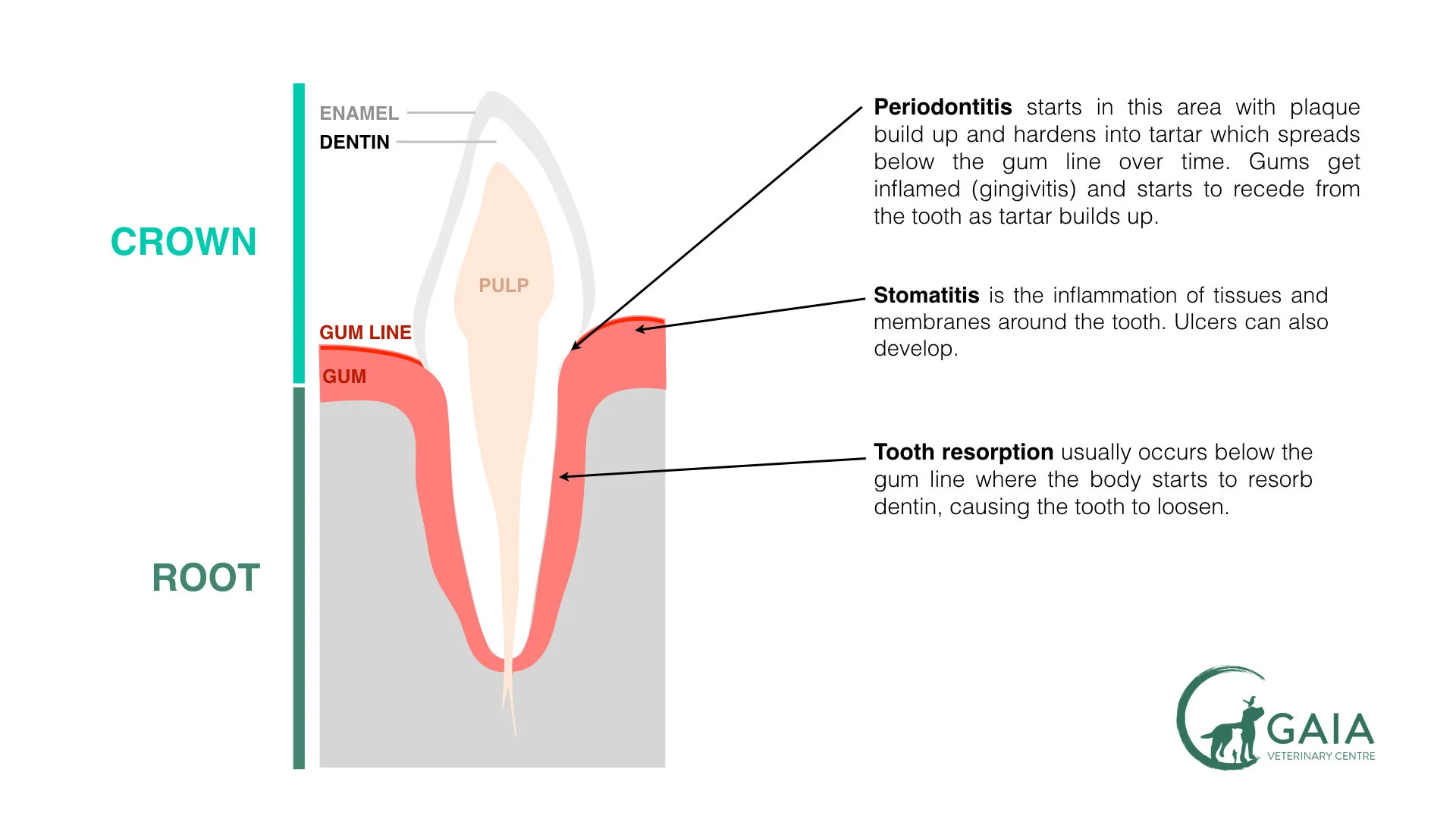3 Most Common Dental Diseases in Cats
Home / Gaia Toast / 3 Most Common Dental Diseases in Cats
Hidden in plain sight, dental diseases are like ticking time bombs that can cause your cat a lot of pain and a sizeable dent on your wallet if left untreated. So it really pays to know the symptoms and how to prevent them from developing.
These are the top three most common dental diseases affecting cats:
Periodontitis (Infection of the gums)
Stomatitis (Inflammation and ulceration of oral tissues e.g. gums, cheeks and tongue)
Tooth Resorption (Spontaneous breakdown of tooth structure)
Diagram indicates the areas where each dental infection typically start and develop. In particular, periodontitis starts on the gum line but spreads deeper below, while tooth resorption usually occurs below the gum line i.e. in the root area.
Here’s a simple summary of each disease and what you should look out for:
1) Periodontitis
(a.k.a serious gum infection)
What causes it?
Food particles left behind after a meal and bacteria accumulate to form plaque along the gum line. Plaque develops into tartar which irritates the gums, causing inflammation (or gingivitis). Over time, the tartar builds up and starts to separate the gums from the teeth, creating spaces under the teeth where bacteria can thrive. This bacteria will eventually break down and eat away at the tooth structures.
What are the signs?
Swelling of gums
Redness of gums (a sign of gingivitis)
Sensitive gums which bleed easily when pressed
Lack of appetite
Excessive drooling
Bad breath
*Note: For a complete diagnosis to check how far the infection has progressed, your vet will need to put your cat under anaesthesia and x-ray his mouth.
What’s the worst that can happen?
If left untreated, severe periodontitis can result in tooth, gum tissue and bone loss, which is extremely painful. Your cat may require surgery to extract the rotten teeth and diseased tissues. Periodontitis can also cause stomatitis to develop (see below).
How to prevent it?
Regular brushing of teeth and gums after meals and going for routine health checks annually. In other words, you can’t leave your cat to his own devices when it comes to his teeth.
“You can’t rely on dental treats to clean your cat’s teeth. Regular and correct teeth-brushing is still the most effective preventive measure.” - Dr Claire Tan, Chief Veterinary Surgeon, Gaia Vets
Do you know that periodontitis is so common that by the age of 3, most cats have this infection to some degree? The symptoms are also quite subtle for early detection and if you wait for some of the signs mentioned above, the infection may already be quite advanced and expensive to treat.
2) Stomatitis
(a.k.a. Inflammation & ulceration of tissues)
What causes it?
Causes are not fully understood as yet but it is assumed to be caused by the cat’s own immune system attacking his own oral tissues as an abnormal response to bacteria in the mouth. Many cats which develop stomatitis are also found to be infected with certain viruses or bacteria such as feline immunodeficiency virus (FIV), feline calivirus and feline herpes virus etc. Periodontitis can also cause stomatitis to develop.
What are the signs?
Bad breath
Redness in the gums
Ulcers or lesions in the gums, mouth cheeks and tongue
Swelling in gums due to fluid build-up
Lack of appetite
Loss of weight
*Note: Your vet may conduct blood tests to check for any underlying infections which may cause the stomatitis.
What’s the worst that can happen?
Stomatitis is quite painful and your cat can’t eat properly. Similar to periodontitis, your cat may need to undergo anaesthesia and have his teeth extracted in severe cases.
How to prevent it?
Since periodontitis can cause stomatitis to occur, regular brushing of teeth and gums after meals will prevent its development. Keeping up with your cat’s vaccination schedule to protect him from viruses that can trigger stomatitis will also help.
3) Tooth Resorption
(a.k.a. tooth structure breakdown)
What causes it?
Exact causes for this disease is unknown but the cat’s body seems to resorb dentin, the key structure of the tooth. It starts out like a cavity i.e. a hole in the tooth enamel which grows larger until the entire tooth is destroyed. This results in the tooth becoming loose and exposes the root (where all the blood vessels and nerves are).
Cat breeds such as Persian are at a higher risk for tooth resorption.
All cats can be affected by tooth resorption but the risk increases as cats age and for certain breeds like Persians and Siamese.
What are the signs?
Reluctance to be touched around the mouth due to pain
Reluctance to chew
Excessive drooling, sometimes tinged with blood
Teeth chattering when eating or drinking


